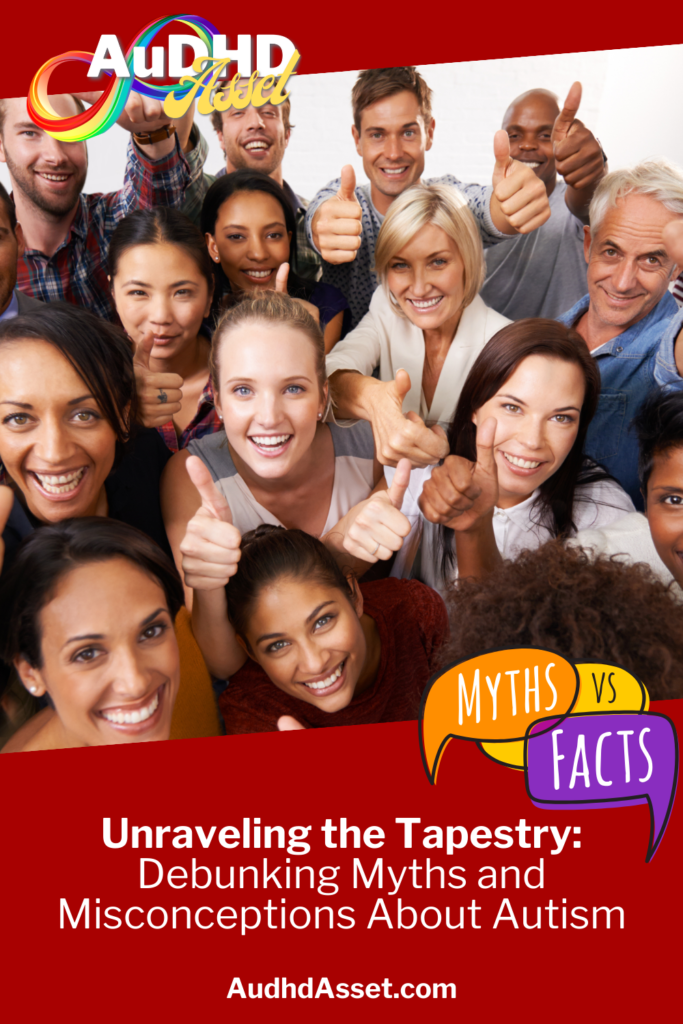Myths and misconceptions surrounding autism are unfortunately prevalent, contributing to misunderstandings and stigma. The stigma surrounding autism can have detrimental effects on autistic individuals and the autism community. With a lack of accurate information, stereotypes perpetuated by media portrayals, and misunderstandings about neurodiversity, we have growing and harmful misconceptions. Despite efforts to debunk these myths, they persist in various forms, highlighting the ongoing need for education, advocacy, and increased awareness about autism and neurodiversity.
Dispelling These Misconceptions
Dispelling myths and misconceptions about autism is crucial for fostering a better understanding and acceptance of neurodiversity. By challenging these misconceptions, we can create a more inclusive society where individuals on the autism spectrum are valued for their unique strengths and contributions. Addressing these myths helps break down barriers to acceptance, promotes empathy, and encourages meaningful engagement with autistic individuals.
To outline the various myths and misconceptions about autism, I’ll highlight several common misconceptions and provide explanations to debunk them. Each myth will be followed by a brief explanation of why it is inaccurate and how it perpetuates misunderstanding and stigma. By addressing these myths head-on, we can promote a more accurate and nuanced understanding of autism, paving the way for greater acceptance and support for individuals on the spectrum.
 Myth #1: Autistic Individuals Lack Empathy
Myth #1: Autistic Individuals Lack Empathy
Autistic individuals commonly are said to lack empathy and/or sympathy. Initially, it was believed that a lack of empathy and sympathy was a universal trait of autism, but recent research indicates this varies. Often, what others perceive as a lack of empathy or sympathy in an autistic individual really is a lack of skills and lack of expressing empathy or sympathy in a way expected by others.
Generally skills to show empathy and sympathy an individual must recognize the other person’s feelings, have an emotional experience to relate personally to another’s feelings, have tools to physically and verbally express those feelings, and have a cultural understanding that displays of empathy are expected and desired by others. Autistic people who struggle to show empathy and sympathy may have difficulty with one or more of these.
There are generally two main types of empathy: cognitive and affective empathy.
Cognitive empathy involves understanding and intellectually grasping another person’s emotions, thoughts, and perspectives (putting yourself in someone else’s shoes). Some autistic individuals may struggle with cognitive empathy particularly in interpreting social cues, non-verbal communication, and understanding subtle emotional expressions. This does not mean they lack cognitive empathy, many autistic individuals have a strong capacity for empathy once they have learned and practiced social skills or have found alternative ways to understand others’ perspectives, such as through explicit communication or logical reasoning.
Affective empathy refers to the ability to emotionally resonate with another person’s feelings. It involves sharing in the emotional experience of another person, feeling what they feel, and responding with appropriate emotions. While some autistic individuals may deeply resonate with other’s emotions and feel them intensely, others may have difficulty recognizing and responding to emotional cues in real-time. Autistic individuals may express empathy in more direct or practical ways, such as offering solutions to problems or showing concerns through their actions rather than through verbal or emotional cues.
 Myth #2: Autism is a Singular, Homogeneous Condition
Myth #2: Autism is a Singular, Homogeneous Condition
Autism is a spectrum disorder, meaning it encompasses a wide range of traits, abilities, and challenges. Autism is characterized by variability in individuals’ traits, behaviors, and needs. Autism is not a one-size-fits-all condition.
Autistic individuals are a diverse group with unique strengths, interests, and experiences. Some may have exceptional abilities in areas such as mathematics, art, or music, while others may face significant challenges in daily living skills. Many autistic individuals have co-occurring conditions such as ADHD, anxiety, or intellectual disability. These conditions contribute to the diversity traits each autistic individual has.
Myth #3: Autism is Caused by Bad Parenting or Vaccines
Research indicates that autism has a strong genetic component. This means that autism is not the result of parenting practices but rather a complex interplay of genetic predispositions and other factors. While parenting can influence a child’s development and behavior, it does not cause autism.
Myth #4: Autistic Individuals Cannot Lead Successful Lives
The myth that autistic individuals cannot lead successful lives stems from a lack of understanding and awareness about autism and its diverse range of characteristics and abilities. Autism manifests differently in each individual. Some autistic individuals may face challenges in certain areas such as social interaction, communication, and sensory processing, but these challenges do not preclude success in other aspects of life.
Many autistic individuals possess unique strengths and talents that can contribute to their success. With appropriate support, accommodations, and understanding from society, autistic individuals can thrive in various domains.
It’s also essential to redefine what success means for autistic individuals. Success doesn’t solely equate to traditional markers such as academic or career achievements. Success can also mean personal fulfillment, independence, meaningful relationships, and contributing positively to society.
 Myth #5: Autistic People Don’t Want Social Connections
Myth #5: Autistic People Don’t Want Social Connections
While it’s true that some autistic individuals may experience social challenges or have different preferences when it comes to social interaction, it’s inaccurate to generalize and assume that they don’t desire social connections.
Autistic individuals, like anyone else, have a fundamental need for social connection and relationships. However, the way they express and navigate social interactions may vary due to differences in neurology and sensory processing.
Autistic traits manifest differently for each individual.
It’s imperative for individuals to seek accurate information about autism to debunk myths and promote understanding. By challenging misconceptions and stereotypes, we create a more inclusive and supportive environment for autistic individuals and their families.
Seeking accurate information allows us to recognize the diverse experiences and strengths within the autism community. It helps us understand that autism for each individual is unique. By embracing this diversity, we can celebrate the contributions and achievements of autistic individuals in various fields.


